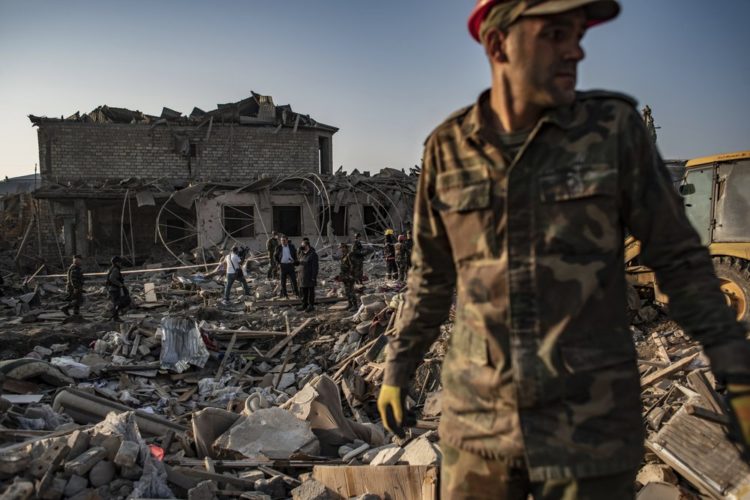The Azerbaijani-Armenian conflict over Nagorno-Karabakh, the disputed territory that borders the two countries, has resulted in nearly 700 military, and many civilian, deaths.
Nagorno-Karabakh lies within Azerbaijan but its population is Armenian. It has been under the control of ethnic Armenian forces backed by Armenia since 1994.
The latest fighting began in late September. It has been the worst in the South Caucasus since the 1990s and has involved heavy artillery, rockets, and drone strikes.
A week ago, a ceasefire was mediated by Russia and agreed to by both sides. But it proved stillborn and collapsed within a week with both sides accusing each other of violations.
Following the Russian ceasefire’s failure, a new one was reached on Saturday. French President Emmanuel Macron welcomed it and stressed that both sides need to be responsible for upholding it.
“This ceasefire must be unconditional and strictly observed by both parties,” the president’s office said in a statement. “France will be very attentive to this and will remain committed so that hostilities cease permanently and that credible discussions can quickly begin.”
The latest ceasefire was to take effect on Saturday midnight.
Yet, on Saturday, Azerbaijan accused Armenia of striking Ganja, its second-largest city, with a ballistic missile. The strike killed at least 13 civilians, including an entire family of five, and wounded 50 others. It destroyed or damaged about 20 residential buildings. Emergency workers spent hours searching in the rubble for survivors.
Azerbaijan’s president, Ilham Aliyev, denounced the missile strike as a war crime and warned the leadership of Armenia that it would face consequences for the attack. Yet, he specified that his country will respond only on the battlefield. Azerbaijani officials list the civilian dead at 60 with an additional 270 wounded since the fighting began on September 27.
Azerbaijani officials said the missile was a 1960s Soviet-made Scud.
Armenia denied responsibility for the missile strike. But separatist authorities in Nagorno-Karabakh, while not claiming responsibility either, alleged “legitimate military targets” in the city.
Already have an account? Sign In
Two ways to continue to read this article.
Subscribe
$1.99
every 4 weeks
- Unlimited access to all articles
- Support independent journalism
- Ad-free reading experience
Subscribe Now
Recurring Monthly. Cancel Anytime.
Ceasefire violations continued. On early Sunday afternoon, Azerbaijan claimed to have shot down another Armenian Su-25 ground attack aircraft. According to Azerbaijan’s Defense Ministry, it was the second Su-25 to be downed in the ongoing fighting. Military officials said the Su-25 was conducting airstrikes in the Jabrayil region against Azerbaijani military forces when it was shot down at approximately 12:30 p.m. The ministry didn’t elaborate on how the aircraft was shot down.
“Armenian forces grossly violated another agreement,” the Azerbaijani ministry released in a statement. It said that Armenia had fired artillery and mortars and had launched early morning attacks along the front lines. It added that the Azerbaijani army “took adequate retaliatory measures.”
Meanwhile, Shushan Stepanyan, a spokeswoman for Armenia’s defense ministry, said on Twitter that Azerbaijan fired artillery shells and rockets in the early hours of Sunday. Military officials in Nagorno-Karabakh said that Azerbaijani forces attacked military positions of the enclave and that both sides suffered casualties.
Armenia is supported by Russia. It uses Soviet-era military equipment, most of which is very outdated. Azerbaijan is using more modern rocket and drone systems supplied by Turkey.
The two countries had fought each other in the early 90s. That war, which ended in 1994, had caused 30,000 casualties.
Lead image: Associated Press.











COMMENTS
You must become a subscriber or login to view or post comments on this article.